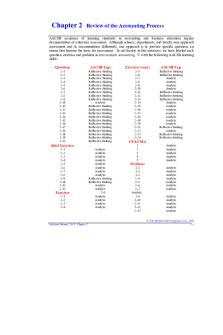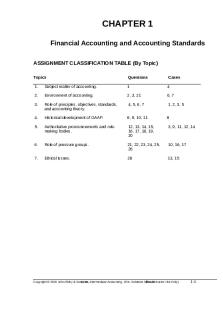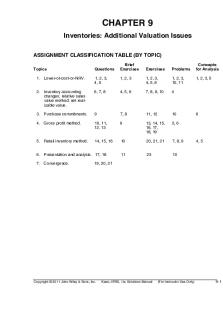INtermediate spiceland solution Ch 4 PDF

| Title | INtermediate spiceland solution Ch 4 |
|---|---|
| Course | Accounting 7511 |
| Institution | University of Memphis |
| Pages | 86 |
| File Size | 1.1 MB |
| File Type | |
| Total Downloads | 34 |
| Total Views | 132 |
Summary
INtermediate accounting spiceland solution Ch 4 practice materials...
Description
Chapter 04 - The Income Statement and Statement of Cash Flows
Chapter 4
The Income Statement and Statement of Cash
Flows (Spiceland 6th ed)
QUESTIONS FOR REVIEW OF KEYQuestion TOPICS 4-1 The income statement is a change statement that reports transactions — revenues, expenses, gains and losses — that cause owners’ equity to change during a specified reporting period.
Question 4-2 Income from continuing operations includes the revenue, expense, gain, and loss transactions that will probably continue in future periods. It is important to segregate the income effects of these items because they are the most important transactions in terms of predicting future cash flows.
Question 4-3 Operating income includes revenues and expenses and gains and losses that are directly related to the principal revenue generating activities of the company. Nonoperating income includes items that are not directly related to these activities.
Question 4-4 The single-step format first lists all revenues and gains included in income from continuing operations to arrive at total revenues and gains. All expenses and losses are then grouped and subtotaled, subtracted from revenues and gains to arrive at income from continuing operations. The multiple-step format reports a series (multiple) of intermediate totals such as gross profit, operating income, and income before taxes. Very often income statements adopt variations of these formats, falling somewhere in between the two extremes.
Question 4-5 The term earnings quality refers to the ability of reported earnings (income) to predict a company’s future earnings. After all, an income statement simply reports on events that already have occurred. The relevance of any historical-based financial statement hinges on its predictive value.
Question 4-6 Restructuring costs include costs associated with shutdown or relocation of facilities or downsizing of operations. They are reported as an operating expense in the income statement.
4-1
Chapter 04 - The Income Statement and Statement of Cash Flows
Question 4-7 The process of intraperiod tax allocation matches tax expense or tax benefit with each major component of income, specifically continuing operations and any item reported below continuing operations. The process is necessary to achieve the desired result of separating the total income effects of continuing operations from the two separately reported items - discontinued operations and extraordinary items, and also to show the after-tax effect of each of those two components.
Answers to Questions (continued) Question 4-8 The net-of-tax income effects of a discontinued operation must be disclosed separately in the income statement, below income from continuing operations. The income effects include income (loss) from operations and gain (loss) on disposal. The gain or loss on disposal must be disclosed either on the face of the statement or in a disclosure note. If the component is held for sale but not sold by the end of the reporting period, the income effects will include income (loss) from operations and an impairment loss if the fair value less costs to sell is less than the book value of the component’s assets. The income (loss) from operations of the component is reported separately in discontinued operations on prior income statements presented for comparative purposes.
Question 4-9 Extraordinary items are material gains and losses that are both unusual in nature and infrequent in occurrence, taking into account the environment in which the entity operates.
Question 4-10 Extraordinary gains and losses are presented, net of tax, in the income statement below discontinued operations, if any.
4-2
Chapter 04 - The Income Statement and Statement of Cash Flows
Answers to Questions (continued) Question 4-11 GAAP permit alternative treatments for similar transactions. Common examples are the choice among FIFO, LIFO, and average cost for the measurement of inventory and the choice among alternative revenue recognition methods. A change in accounting principle occurs when a company changes from one generally accepted treatment to another. In general, we report voluntary changes in accounting principles retrospectively. This means revising all previous periods’ financial statements as if the new method were used in those periods. In other words, for each year in the comparative statements reported, we revise the balance of each account affected. Specifically, we make those statements appear as if the newly adopted accounting method had been applied all along. Also, if retained earnings is one of the accounts whose balance requires adjustment (and it usually is), we revise the beginning balance of retained earnings for the earliest period reported in the comparative statements of shareholders’ equity (or statements of retained earnings if they’re presented instead). Then we create a journal entry to adjust all account balances affected as of the date of the change. In the first set of financial statements after the change, a disclosure note would describe the change and justify the new method as preferable. It also would describe the effects of the change on all items affected, including the fact that the retained earnings balance was revised in the statement of shareholders’ equity along with the cumulative effect of the change in retained earnings. An exception is a change in depreciation, amortization, or depletion method. These changes are accounted for as a change in estimate, rather than as a change in accounting principle. Changes in estimates are accounted for prospectively. The remaining book value is depreciated, amortized, or depleted, using the new method, over the remaining useful life.
Question 4-12 A change in accounting estimate is accounted for in the year of the change and in subsequent periods; prior years’ financial statements are not restated. A disclosure note should justify that the change is preferable and should describe the effect of a change on any financial statement line items and per share amounts affected for all periods reported.
Question 4-13 Prior period adjustments are accounted for by restating prior years’ financial statements when those statements are presented again for comparison purposes. The beginning of period retained earnings is increased or decreased on the statement of shareholders’ equity (or the statement of retained earnings) as of the beginning of the earliest period presented.
4-3
Chapter 04 - The Income Statement and Statement of Cash Flows
Answers to Questions (concluded) Question 4-14 Earnings per share (EPS) is the amount of income achieved during a period for each share of common stock outstanding. If there are different components of income reported below continuing operations, their effects on earnings per share must be disclosed. If a period contains discontinued operations and extraordinary items, EPS data must be reported separately for income from continuing operations and net income. Per share amounts for discontinued operations and extraordinary items would be disclosed on the face of the income statement.
Question 4-15 Comprehensive income is the total change in equity for a reporting period other than from transactions with owners. Reporting comprehensive income can be accomplished with a separate statement or by including the information in either the income statement or the statement of changes in shareholders’ equity.
Question 4-16 The purpose of the statement of cash flows is to provide information about the cash receipts and cash disbursements of an enterprise during a period. Similar to the income statement, it is a change statement, summarizing the transactions that caused cash to change during a particular period of time.
Question 4-17 The three categories of cash flows reported on the statement of cash flows are: 1. Operating activities — Inflows and outflows of cash related to the transactions entering into the determination of net income from operations. 2. Investing activities — Involve the acquisition and sale of (1) long-term assets used in the business and (2) nonoperating investment assets. 3. Financing activities — Involve cash inflows and outflows from transactions with creditors and owners.
Question 4-18 Noncash investing and financing activities are transactions that do not increase or decrease cash but are important investing and financing activities. An example would be the acquisition of property, plant and equipment (an investing activity) by issuing either long-term debt or equity securities (a financing activity). These activities are reported either on the face of the statement of cash flows or in a disclosure note.
Question 4-19 The direct method of reporting cash flows from operating activities presents the cash effect of each operating activity directly on the statement of cash flows. The indirect method of reporting cash flows from operating activities is derived indirectly, by starting with reported net income and adding and subtracting items to convert that amount to a cash basis.
4-4
Chapter 04 - The Income Statement and Statement of Cash Flows
Question 4-20 There are two possible separately reported items that could appear in income statements, discontinued operations and extraordinary items. International Financial Reporting Standards (IFRS) prohibit reporting extraordinary items.
Question 4-21 IFRS provides the option of presenting components of other comprehensive income either in (a) a single statement of comprehensive income or (b) in a separate income statement followed by a statement of comprehensive income. U.S. GAAP also allows the reporting of other comprehensive income in the statement of shareholders’ equity
Question 4-22 U.S. GAAP designates cash outflows for interest payments and cash inflows from interest and dividends received as operating cash flows. Dividends paid to shareholders are classified as financing cash flows. IFRS allows more flexibility. Companies can report interest and dividends paid as either operating or financing cash flows and interest and dividends received as either operating or investing cash flows. Interest and dividend payments usually are reported as financing activities. Interest and dividends received normally are classified as investing activities
4-5
Chapter 04 - The Income Statement and Statement of Cash Flows
BRIEF EXERCISES Brief Exercise 4-1 PACIFIC SCIENTIFIC CORPORATION Income Statement For the Year Ended December 31, 2011 ($ in millions)
Revenues and gains: Sales .................................................................. Gain on sale of investments .............................. Total revenues and gains ...............................
$2,106 45 2,151
Expenses and losses: Cost of goods sold ............................................ Selling................................................................ General and administrative................................ Interest............................................................... Income tax expense* ........................................ Total expenses and losses ............................. Net income ..........................................................
$1,240 126 105 35 258 1,764 $ 387
*$2,151 – (1,240 + 126 + 105 + 35) = $645 x 40% = $258 (a)
Sales revenue Brief Exercise 4-2 Less: Cost of goods sold Gross profit Less: Selling expenses (126) General and administrative expenses (105) Operating income $ 635 (b)
Gain on sale of investments Interest expense
45 (35)
Nonoperating income
$10
4-6
$2,106 (1,240) 866
Chapter 04 - The Income Statement and Statement of Cash Flows
Brief Exercise 4-3
PACIFIC SCIENTIFIC CORPORATION Income Statement For the Year Ended December 31, 2011 ($ in millions)
Sales revenue ....................................................... Cost of goods sold ............................................... Gross profit .......................................................... Operating expenses: Selling................................................................ General and administrative................................ Total operating expenses ............................... Operating income ................................................ Other income (expense): Gain on sale of investments .............................. Interest expense ................................................ Total other income, net ................................. Income before income taxes ............................... Income tax expense* ........................................... Net income ..........................................................
*$645 x 40%
4-7
$2,106 1,240 866 $126 105 231 635 45 (35) 10 645 258 $ 387
Chapter 04 - The Income Statement and Statement of Cash Flows
Brief Exercise 4-4 (a)
Sales revenue Less: Cost of goods sold General and administrative expenses Restructuring costs Selling expenses Operating income
(b)
Operating income Add: Interest revenue Deduct: Loss on sale of investments Income before income taxes and Extraordinary item Income tax expense (40%) Income before extraordinary item
$25,000 4,000 (22,000)
Income before extraordinary item Extraordinary item: Loss from flood damage, net of $20,000 tax benefit Net loss
$ 4,200
(c)
4-8
$300,000 (160,000) (40,000) (50,000) (25,000) $ 25,000
7,000 (2,800) $ 4,200
(30,000) (25,800)
Chapter 04 - The Income Statement and Statement of Cash Flows
Brief Exercise 4-5 MEMORAX COMPANY Partial Income Statement For the Year Ended December 31, 2011 Income before income taxes and extraordinary item........... Income tax expense* .......................................................... Income before extraordinary item ....................................... Extraordinary item: Loss from earthquake, net of $208,000 tax benefit.......... Net income .......................................................................... *$790,000 x 40%
4-9
$ 790,000 316,000 474,000 (312,000) $ 162,000
Chapter 04 - The Income Statement and Statement of Cash Flows
Brief Exercise 4-6 WHITE AND SONS, INC. Partial Income Statement For the Year Ended December 31, 2011 Income before income taxes and extraordinary item........... Income tax expense* .......................................................... Income before extraordinary item ....................................... Extraordinary item: Loss from earthquake, net of $160,000 tax benefit.......... Net income .......................................................................... Earnings per share: Income before extraordinary item........................................ Loss from earthquake ......................................................... Net income ..........................................................................
$ 850,000 340,000 510,000 (240,000) $ 270,000 $ 5.10 (2.40) $ 2.70
*$850,000 x 40% Note: Restructuring costs, interest revenue, and loss on sale of investments are included in income before income taxes and extraordinary item.
4-10
Chapter 04 - The Income Statement and Statement of Cash Flows
Brief Exercise 4-7 CALIFORNIA MICROTECH CORPORATION Partial Income Statement For the Year Ended December 31, 2011 Income from continuing operations before income taxes.... $ 5,800,000 Income tax expense* ........................................................... 1,740,000 Income from continuing operations .................................... $ 4,060,000 Discontinued operations: Loss from operations of discontinued component (including gain on disposal of $2,000,000)** .......................... (1,600,000) Income tax benefit ............................................................ 480,000 Loss on discontinued operations ...................................... (1,120,000) Net income .......................................................................... $ 2,940,000 * $5,800,000 x 30% ** Loss from operations of discontinued component: Gain on sale of assets Operating loss Total before-tax loss
$ 2,000,000 ($10 million less $8 million) (3,600,000) $(1,600,000)
4-11
Chapter 04 - The Income Statement and Statement of Cash Flows
Brief Exercise 4-8 CALIFORNIA MICROTECH CORPORATION Partial Income Statement For the Year Ended December 31, 2011 Income from continuing operations before income taxes.... Income tax expense* ........................................................... Income from continuing operations .................................... Discontinued operations: Loss from operations of discontinued component** ....... Income tax benefit ............................................................ Loss on discontinued operations ...................................... Net income .......................................................................... * $5,800,000 x 30% ** Includes only the operating loss. There is no impairment loss.
4-12
$ 5,800,000 1,740,000 $ 4,060,000 (3,600,000) 1,080,000 (2,520,000) $ 1,540,000
Chapter 04 - The Income Statement and Statement of Cash Flows
Brief Exercise 4-9 CALIFORNIA MICROTECH CORPORATION Partial Income Statement For the Year Ended December 31, 2011 Income from continuing operations before income taxes.... $ 5,800,000 Income tax expense* ........................................................... 1,740,000 Income from continuing operations .................................... $ 4,060,000 Discontinued operations: Loss from operations of discontinued component (including impairment loss of $1,000,000)** .......................... (4,600,000) Income tax benefit ............................................................ 1,380,000 Loss on discontinued operations ...................................... (3,220,000) Net income .......................................................................... $ 840,000 * $5,800,000 x 30% ** Loss from operations of discontinued component: Impairment loss ($8 million book value less $7 million net fair value) Operating loss Total before-tax loss
4-13
$(1,000,000) (3,600,000) $(4,600,000)
Chapter 04 - The Income Statement and Statement of Cash Flows
Brief Exercise 4-10 The change in inventory method is a change in accounting principle. The depreciation method change is considered to be a change in accounting estimate that is achieved by a change in accounting principle and is accounted for prospectively, exactly as we would account for any other change in estimate. The inventory method change, however, is accounted for by retrospectively recasting prior years’ financial statements presented with the current year for comparative purposes, applying the new inventory method (FIFO in this case) in those years. This is a change in accounting estimate.
Brief Exercise 4-11
When an estimate is revised as new information comes to light, accounting for the change in estimate is quite straightforward. We do not restate prior years' financial statements to reflect the new estimate. Instead, we merely incorporate the new estimate in any related accounting determinations from there on. If the after-tax income effect of the change in estimate is material, the effect on net income and earnings per share must be disclosed in a note, along with the justification for the change. Depreciation for 2011 is $25,000: $300,000
Cost $ 50,000 Previous annual ...
Similar Free PDFs

INtermediate spiceland solution Ch 4
- 86 Pages

Solution ch 4
- 24 Pages

Assignment 04 - ch 4 solution
- 3 Pages

Ch.4 SM - Solution manual
- 73 Pages

Cumulative Coverage Ch 2-4 solution
- 12 Pages

Solution Ch21 of Intermediate Accounting
- 143 Pages

Solution ch 6
- 6 Pages
Popular Institutions
- Tinajero National High School - Annex
- Politeknik Caltex Riau
- Yokohama City University
- SGT University
- University of Al-Qadisiyah
- Divine Word College of Vigan
- Techniek College Rotterdam
- Universidade de Santiago
- Universiti Teknologi MARA Cawangan Johor Kampus Pasir Gudang
- Poltekkes Kemenkes Yogyakarta
- Baguio City National High School
- Colegio san marcos
- preparatoria uno
- Centro de Bachillerato Tecnológico Industrial y de Servicios No. 107
- Dalian Maritime University
- Quang Trung Secondary School
- Colegio Tecnológico en Informática
- Corporación Regional de Educación Superior
- Grupo CEDVA
- Dar Al Uloom University
- Centro de Estudios Preuniversitarios de la Universidad Nacional de Ingeniería
- 上智大学
- Aakash International School, Nuna Majara
- San Felipe Neri Catholic School
- Kang Chiao International School - New Taipei City
- Misamis Occidental National High School
- Institución Educativa Escuela Normal Juan Ladrilleros
- Kolehiyo ng Pantukan
- Batanes State College
- Instituto Continental
- Sekolah Menengah Kejuruan Kesehatan Kaltara (Tarakan)
- Colegio de La Inmaculada Concepcion - Cebu








